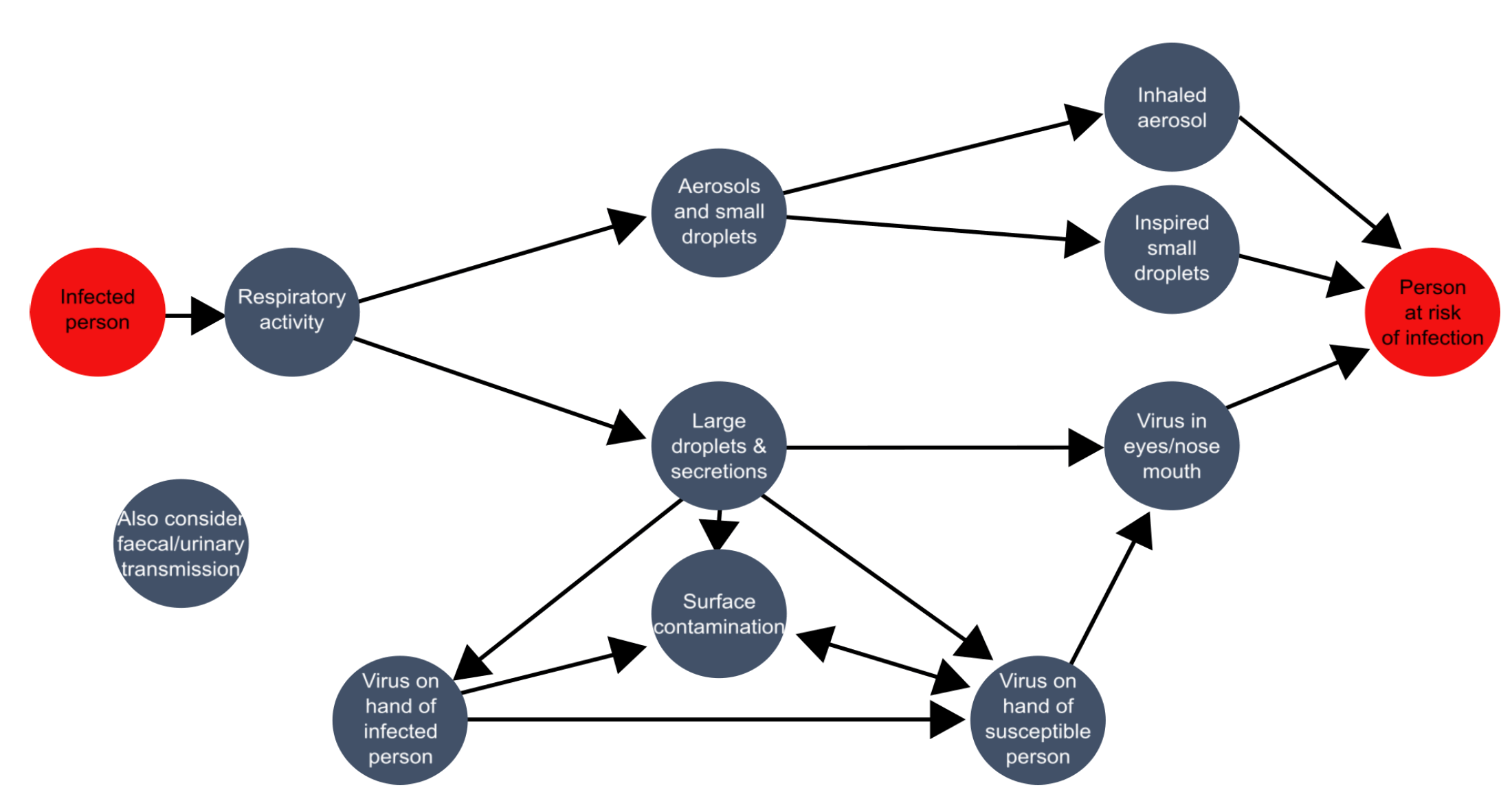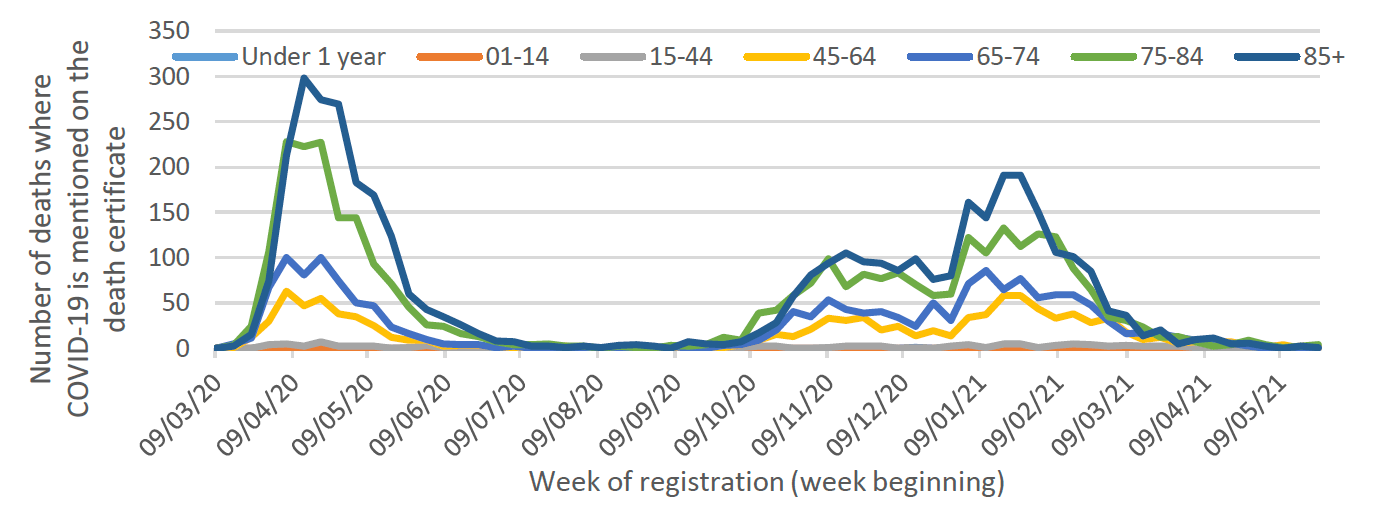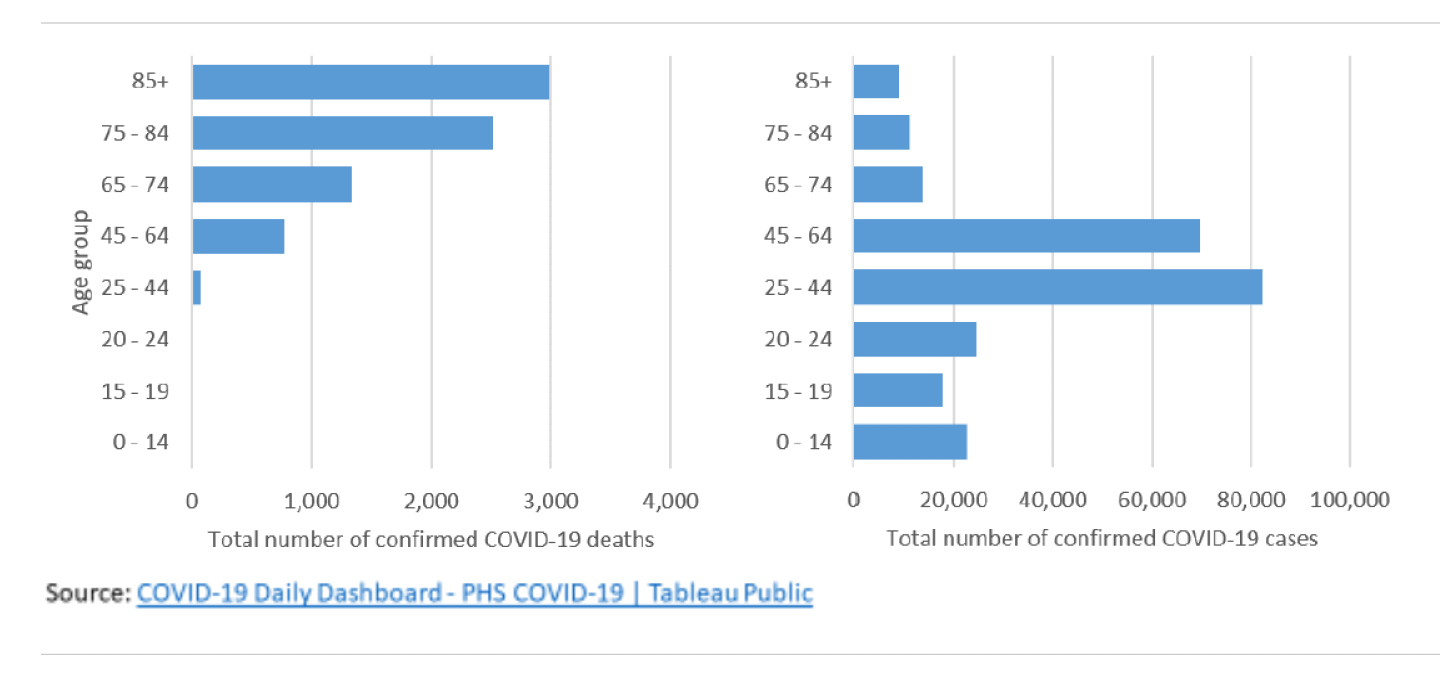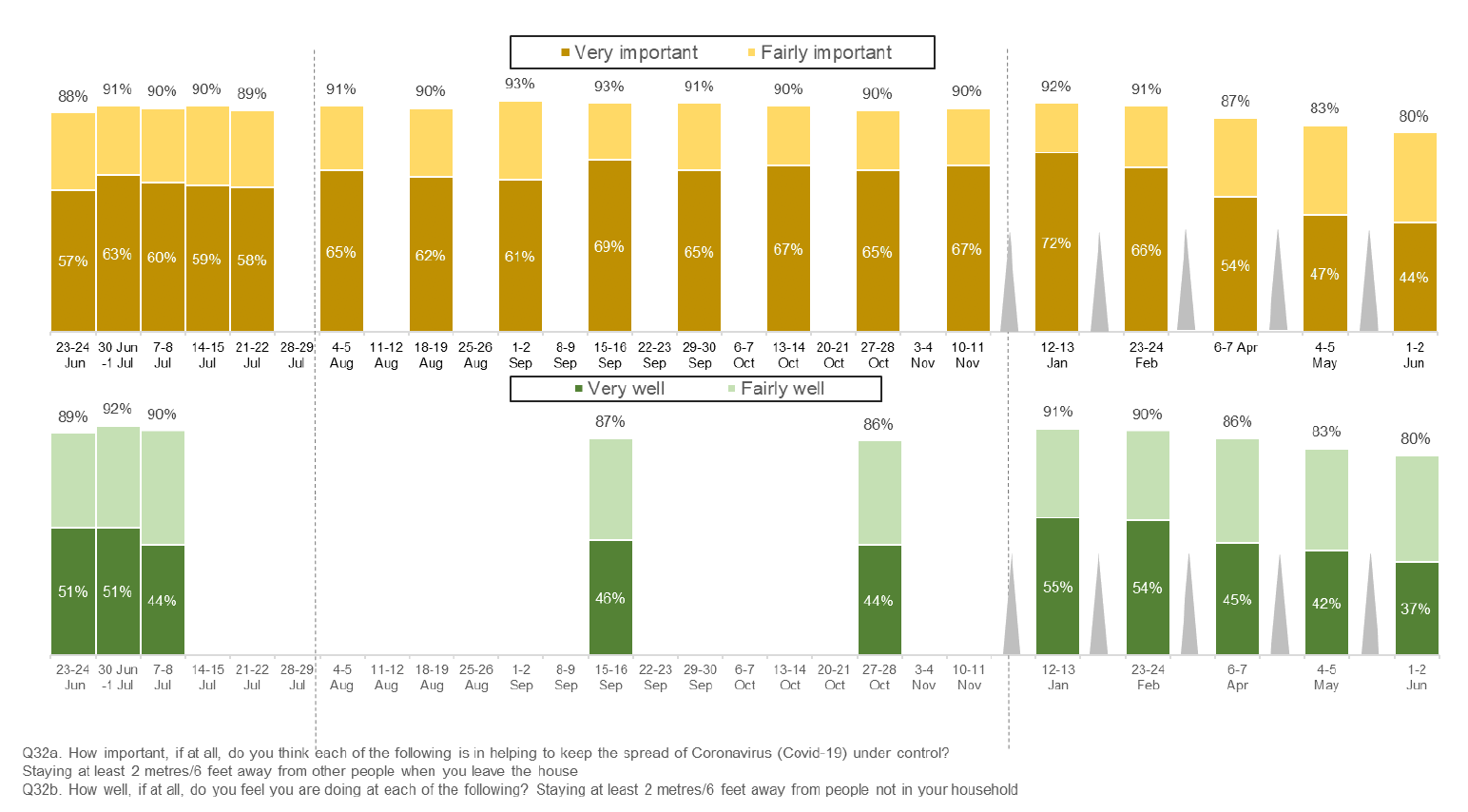Coronavirus (COVID-19): review of physical distancing in Scotland - June 2021
Sets out the outcome of a review of physical distancing in public places, taking account of the science, and the current and projected state of the epidemic in Scotland in light of our vaccine roll-out and the ‘four harms’ of the virus.
The impact of physical distancing in reducing the spread of the virus
Current evidence suggests that the virus spreads mainly between people who are in close contact with each other.[10] Infection can occur when aerosols or droplets containing the virus are breathed in or come into contact with the eyes, nose, or mouth. Transmission risk is increased in indoor places that are poorly ventilated or crowded, and where people tend to spend longer periods of time.This is because aerosols remain suspended in the air and there is increasing evidence of airborne transmission over longer distances in some situations.[11] [12]
Physical distancing and use of face coverings are therefore both important measures to reduce transmission of coronavirus. Factors that affect transmission include:[13]
- Length and frequency of exposures (time);
- Proximity or physical contact with an infected individual (non-linear relationship with distance);
- Number of people within a space (likelihood of presence of an infectious person and greater potential for secondary cases);
- Infectiousness of individuals, which may differ between viral variants; and
- Community prevalence, as the lower the prevalence the less likely you are to be in contact with someone who is infectious.
The Environmental and Modelling Group (EMG) says with high confidence that coronavirus transmission is strongly associated with proximity, duration and frequency of contact and community prevalence. The highest risks of transmission are associated with poorly ventilated and crowded indoor settings.[14] In shared indoor spaces, there is no guaranteed safe distance to maintain from others, but maintaining a distance around 2 metres as far as possible and reducing the time of exposure is likely to reduce the risk of infection. Very short duration closer exposures are unlikely to pose a significant risk, especially outdoors. [15]

The World Health Organization (WHO) advises to stay at least 1 metre away from others[17] and there is evidence suggesting that there is a substantial difference in risk of exposure between 2 metre and 1 metres, perhaps as much as 2-10 times, although this will be vary depending on the context.[18] The Scientific Advisory Group for Emergencies (SAGE) and the EMG say that there is a significant reduction in exposure to all virus-containing droplets where around 2 metres of distance is maintained.[19]
As new, more transmissible variants of concern have emerged, including the Alpha and Delta variants, mitigations such as physical distancing assume even greater importance. In settings where it is not possible to maintain a 2 metre physical distance, additional mitigations are required to reduce exposure to respiratory particles. Risk assessments should consider the environment and possible mitigations, which could include face coverings, face visors, well designed screens or barriers placed between people, increased ventilation, hand hygiene and measures to reduce the duration of exposure.
The impact of the vaccination programme
Whilst we have seen the advent of new, more transmissible coronavirus variants in the course of the pandemic which make it more difficult to suppress the virus, our vaccination programme is mitigating the impact of new variants by having a positive impact in both reducing transmission and health harms.
Figure 2 below shows that, compared with the first peak in COVID-19 deaths, the early effects of the vaccination programme were beginning to reduce the proportion of deaths in older age-groups in the second peak. Combined with the success of protective measures in suppressing the second peak, this progress permitted us to consider the increased relaxation of restrictions in certain activities and settings, with important wide-ranging positive benefits for individuals, families and businesses.

By prioritising the most vulnerable groups, vaccination should significantly reduce COVID-19 morbidity and mortality, illustrated in Figure 3 below.

In part as a consequence of the vaccine's protection of older people (who have been prioritised), a higher proportion of new coronavirus cases are occurring among younger people who are less susceptible to severe COVID-19 disease. This is shown in the increase in the proportion of cases in younger people. The larger proportion of cases in the youngest age group may indicate a different pattern of infections caused by the Delta variant.
Four harms considerations
In light of the latest developments in the pandemic – particularly the advent of the Delta variant and the significant decline in morbidity and mortality associated with COVID-19 in Scotland as a result of our vaccination roll-out - we have carefully considered the necessity and proportionality of our current approach to physical distancing and the continued respect for, and protection of, fundamental human rights. Consideration of the "four harms" provides a lens through which to assess the overall impacts of our current policy and to consider the timings and scope for making changes in a safe way.
In considering the "four harms", it is important to note that whilst evidence provides an insight into many of the emerging impacts of physical distancing, it will only show an incomplete picture. Physical distancing policy has led to direct and indirect impacts on all settings and sectors and it is challenging to isolate the unique impact of physical distancing measures and behaviours from the other elements of the response, such as the wearing of face coverings and travel restrictions, for example. It is likely that the various impacts of COVID-19 on society and the economy are the consequence of a combination of factors. A compilation of current evidence on the impacts of physical distancing across the four harms (available through government data sources and external studies and reports)[20] is outlined in Annex A.
Some of the key findings can be summarised as follows:
Harm 1 – Direct health impacts
- Multiple factors affect the risk of transmission of coronavirus, including the distance, duration and frequency of contact between individuals; the community prevalence of COVID-19 cases; and the ventilation and crowdedness of settings where people meet.
- Physical distancing is a key mitigation for reducing the transmission of the virus and associated direct health harms, as close contact for prolonged periods, particularly indoors with poor ventilation and no face masks, poses a high transmission risk.
- The impact of the vaccination roll-out is helping to weaken the link between COVID-19 case numbers and morbidity and mortality.
Harm 2 – Health impacts not directly related to COVID-19
- Secondary care is continuing to operate at reduced capacity and with waiting lists. Delays in treatment may lead to worse outcomes, impacting on quality of life and the scale and cost of intervention required. Physical distancing measures will have impacted on this, but it is difficult to establish the precise scale of the impact.
- GP and other services have remained available throughout the pandemic, but have been impacted by challenges of restrictions on face-face activity. Any loss or limitation of the preventative/early intervention role of primary care during the pandemic is a cause for concern. For many serious conditions, delays in treatment will lead to worse outcomes. Physical distancing measures will have impacted on this, but again it is difficult to establish the precise scale of the impact.
- Mental health and wellbeing has been impacted by the COVID-19 pandemic, which might be a result of the virus itself (e.g. anxiety around contracting it) and/or associated mitigation measures (e.g., physical distancing).
Harm 3 - Social impacts
- Although it is not possible to isolate the effects of physical distancing restrictions from other control measures, there is consistent evidence of negative societal impacts over the course of the pandemic. This includes a large reduction in social connectivity, and higher levels of loneliness and anxiety, particularly for younger people. There is also evidence of reduced social and community cohesion, which may be associated with distancing measures.
- Other data has shown reduced incomes for some households, particularly for self-employed workers, and people living in more deprived areas in Scotland.
- Evidence also highlights negative impacts on children and young people during the pandemic, from lost social interactions, changes to learning experiences, variations in access to home learning equipment, and reduced contact with friends and networks, particularly during the period of stronger restrictions.
- Physical distancing rules have had an impact on the justice system, and there is evidence of backlogs in these systems that have led to delays for victims, witnesses and accused, and an increase in remand numbers.
- The 2m physical distancing requirements have meant that some businesses and services are unable to operate in a viable way. The resulting closures have reduced opportunities for participation in culture, leisure and tourism. This has had an impact on individual and community wellbeing.
Harm 4 – Economic impacts
- Economic harm is strongly linked to social harm and the impacts of the pandemic have been unequal across sectors, groups and regions. Physical distancing, in its widest sense, has impacted negatively on economic activity in a number of different ways and has affected almost all businesses. The requirement for physical distancing has constrained the capacity of consumer facing parts of the economy impacting on their profitability, sometimes to the extent that they are no longer commercially viable and are unable to open. The requirement for staff members to remain distanced has also had a impact on areas such as productivity in the manufacturing sector and research and development in laboratories.
- Physical distancing has not only led to economic harm and social harm, but it has also exacerbated wider health harms through its effect on mental health and wellbeing, including that of business owners. Sectors such as culture, arts and tourism, for example, have been shown to improve wellbeing and social cohesion.
- Even for the sectors and businesses that have remained open (or those that have recently reopened), physical distancing requirements have had an economic impact through restricting throughput and affecting the extent to which a business is viable operating at reduced capacity.
- As we move forward into level 0 we will start to see a staged return of the workforce to offices. The current requirements for physical distancing would constrain office capacities meaning that working from home would still be necessary for some. This is likely to have a negative effect on city centre economies, as well as potential impacts on productivity and morale in the workplace.
- Physical distancing on public transport, even with the reduced distance of 1m applying, has constrained capacity to 30-40%. The increasing capacity challenge has become more acute in recent weeks following the easings on 26 April and 17 May. With the economy and society gradually opening up over the summer capacity pressures will increase.
- Even if restrictions on physical distancing are removed entirely, there is uncertainty around how much voluntary physical distancing will persist and so the economic impacts of physical distancing could remain to an extent or lead to displacement effects.
- A divergence in physical distancing rules and restrictions between Scotland and the rest of the UK could put businesses in Scotland that are in direct competition with businesses in the rest of the UK at a competitive disadvantage.
Stakeholder engagement
A wide range of stakeholder engagement is undertaken regularly by the Scottish Government. Regular meetings take place with industry and sector representative bodies to disseminate information and to ensure that the impact of COVID protective measures is well understood and that where possible, issues are addressed. Physical distancing requirements have been raised by all of those we have engaged with as a significant barrier - including by representatives of the performing arts, hospitality, events and life events sectors, places of worship, and others. Through this engagement we have put in place less restrictive measures where it was deemed both appropriate and possible to do so (e.g. for hospitality), and prepared guidance to ensure issues raised by sectors were addressed in the most appropriate way possible.
For businesses, we recognise that any degree of distancing between staff and customers significantly affects operations and commercial viability. For example, although some people may enjoy attending events in an uncrowded setting, the majority of theatres, comedy clubs, and live music venues may not be viable until the current physical distancing restrictions are removed entirely. We have been told that economic viability is linked to filling venues near to full or full capacity. Business representatives have also expressed concern that more lenient distancing rules in England may have a displacement effect on their business.
Issues in relation to physical distancing have also been frequently raised in the context of life events, such as weddings and civil partnerships and funerals, given their emotive nature and the desire for close contact between members of different households. This is often also the case in relation to places of worship, where reducing or removing physical distancing requirements will allow full congregations to come together once more.
Within this context, we understand that it is crucial to provide as much clarity as possible to individuals, businesses, organisations and places of worship about how and when capacity limits will be removed. Our ongoing discussions with stakeholders will continue as we take our next steps in easing distancing restrictions and we are grateful to them for continuing to engage with us and sticking with measures until they can be safely eased.
Physical distancing practice
The extent of physical distancing in society and the economy since the start of the pandemic, and levels of public understanding, support and adherence provide context for our review of current measures.
Evidence from Scottish Government commissioned weekly public attitudes polling shows that since the beginning of the pandemic in 2020 and the introduction of physical distancing restrictions, a high majority of people have regarded 'staying at least 2 metres/6 feet away from other people' as very/fairly important.[21]
The most recent measure at the start of June 2021 (Source: YouGov) showed that 80% of people regarded this as very/fairly important, including 44% of people who regarded this as 'very important'.
This appears to be changing, as the proportion was higher at earlier stages of the pandemic, when it was between 88%-97% (in surveys between May 2020 and February 2021). The most recent measure of 80% (1-2 June 2021) was the lowest level of agreement that has been recorded in the survey to date. The proportion of people who regarded physical distancing as 'very' important had also dropped to 44%, from 72% in mid-January. This suggests that there has been a change in public attitudes to physical distancing, with the public regarding it as less important than it was previously.
This data also shows that physical distancing/staying 2m away from other people (80%) is not regarded to be as important as other protective behaviours, including isolating and booking a test at the first sign of symptoms (92%), avoiding crowded/busy places (88%), and wearing a face covering (84%).

The Scottish Government weekly public attitudes survey conducted by YouGov also asks about self-reported adherence to physical distancing, and it has reported high levels of adherence to physical distancing behaviours since the beginning of the pandemic.
Adherence to distancing guidance has reduced slightly during spring 2021, as the number of reported infections has decreased. The most recent measure (1-2 June 2021) shows that 80% reported doing very/fairly well at staying at least 2 metres/6 feet away from people. Again, this represents a reduction from earlier in the pandemic, when levels were recorded as 94%-96% in April and May 2020, and 91% on 12-13 January 2021. The proportion who said they were doing 'very well' had also reduced from 55% on 12-13 January 2021, to 37% on 1-2 June 2021.
Adherence to distancing behaviours is also not as strong as it is for some of other behaviours which help to suppress the virus. The survey data also shows that the public are slightly more likely to report themselves as doing very/fairly well, for other protective behaviours, including washing hands (84%), avoiding crowded places (90%) and wearing a face covering when required (94%), compared to 80% for physical distancing.
The barriers to adherence appear to be practical, and do not necessarily reflect a lack of understanding or motivation. When the people who were asked why they rated themselves less positively on adherence to 2m/6ft distancing (YouGov, 23-24 Feb 2021), the most common reasons were connected with the practical ability to distance: 'when I am out, people come into my space' (64%) and 'if it's busy somewhere, it's hard to keep 2m/6ft away from others' (58%).
Perceptions of safety measures within hospitality venues are relatively high. A large majority (89%) of people felt comfortable with measures put in place to protect customers in shops/shopping centres, as well as cafes and restaurants (95%), bars and pubs (89%).[22] Also 69% who visited hospitality in the past week said everyone in the group was asked for their contact details (82% including the response - 'only some people were asked').[23]
Contact
There is a problem
Thanks for your feedback